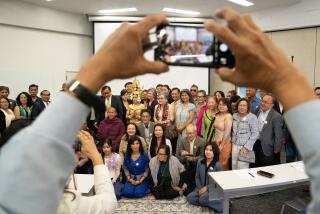Former Khmer Rouge stronghold struggles with history
Reporting from Pailin, Cambodia — Twelfth-grade teacher Sam Borath recently asked her students in Svay, a town in northwestern Cambodia, to write down the names of five leaders of the Khmer Rouge regime that killed an estimated 1.7 million people during its reign in the late 1970s.
Simply identifying top figures, however, can be an awkward exercise. Many communities would rather not stir up memories of the war-torn past, particularly in this region. Svay is part of a thin belt along the northwestern border that remained under the control of ultra-communist Khmer Rouge leaders and their militias for two decades after 1979, when the regime was ousted from power in Phnom Penh. Many residents still defend the regime’s legacy, contending that it had rural interests at heart.
But a new national curriculum requires schools to tackle the controversial topic as a way to confront and reconcile the past.
“Some did it,” Sam Borath said of the writing exercise. “But some just wrote down one name. Others didn’t even hand it in because their parents told them not to.”
Naming specific cadres and their past deeds is sensitive, now that a United Nations-backed war crimes court is prosecuting a few former high-ranking officials and is considering taking on five others.
Students in Svay were introduced to the new lessons in November.
“A lot of the students are curious to know what happened,” Sam Borath said. “But many parents are former Khmer Rouge, so they discourage their kids from learning about it. They think we are teaching their children to be angry at them.”
Researchers estimate that nearly a quarter of Cambodia’s population died under the extremist regime, and most survivors had been pushed to the edge of death by hard labor, starvation and medical neglect.
After the Khmer Rouge was ousted in 1979, Pailin became the base of its insurgency before morphing in the late 1990s into an autonomous zone for former regime leaders who agreed to leave the movement. A decade later, the province has been reincorporated into the country.
In July, a U.N.-backed court handed former Khmer Rouge prison chief Kang Kek Ieu, known as Comrade Duch, what amounted to a 30-year sentence. Two months later, it indicted four former senior leaders on charges that include genocide and crimes against humanity.
The desire in some areas to frustrate such prosecutions, though, was apparent during a recent trip by court officials to Pailin, the provincial capital, to meet with dozens of former Khmer Rouge figures now serving as police officers, soldiers and politicians.
“We want them to realize that we are doing this work for everyone,” said Reach Sambath, a court spokesman.
Convincing former Khmer Rouge cadres that they’ll benefit under a society that prosecutes the regime’s top officials remains a hard sell here, however, even as angry residents in other parts of Cambodia wonder why so few of those leaders have been held accountable.
Mey Meakk, a deputy governor in Pailin province and former secretary to top Khmer Rouge leader Pol Pot, contended that his old boss deserves all the blame and everyone else should be left alone.
The four senior leaders awaiting trial are victims of Pol Pot, he said, “like me, like everyone else.”
Back in the classroom, Pailin’s high school teachers were trying to raise awareness one lesson at a time. Most of them grew up elsewhere and don’t share local sentiments.
“We talk about the torture, how people were evicted from the cities, the endless hard labor,” said Long Vannak, a 12th-grade history teacher who had moved here. “Many of the students are interested in this history.”
Sat Sorya, 20, one of Long Vannak’s students, struggled to make sense of the many disturbing snippets she’d heard over the years from relatives, classmates and the media.
“I want to know why they killed so many of their own people,” she said. “I want to know why they left their own country in such terrible condition.”
Brady is a special correspondent.
More to Read
Sign up for Essential California
The most important California stories and recommendations in your inbox every morning.
You may occasionally receive promotional content from the Los Angeles Times.










